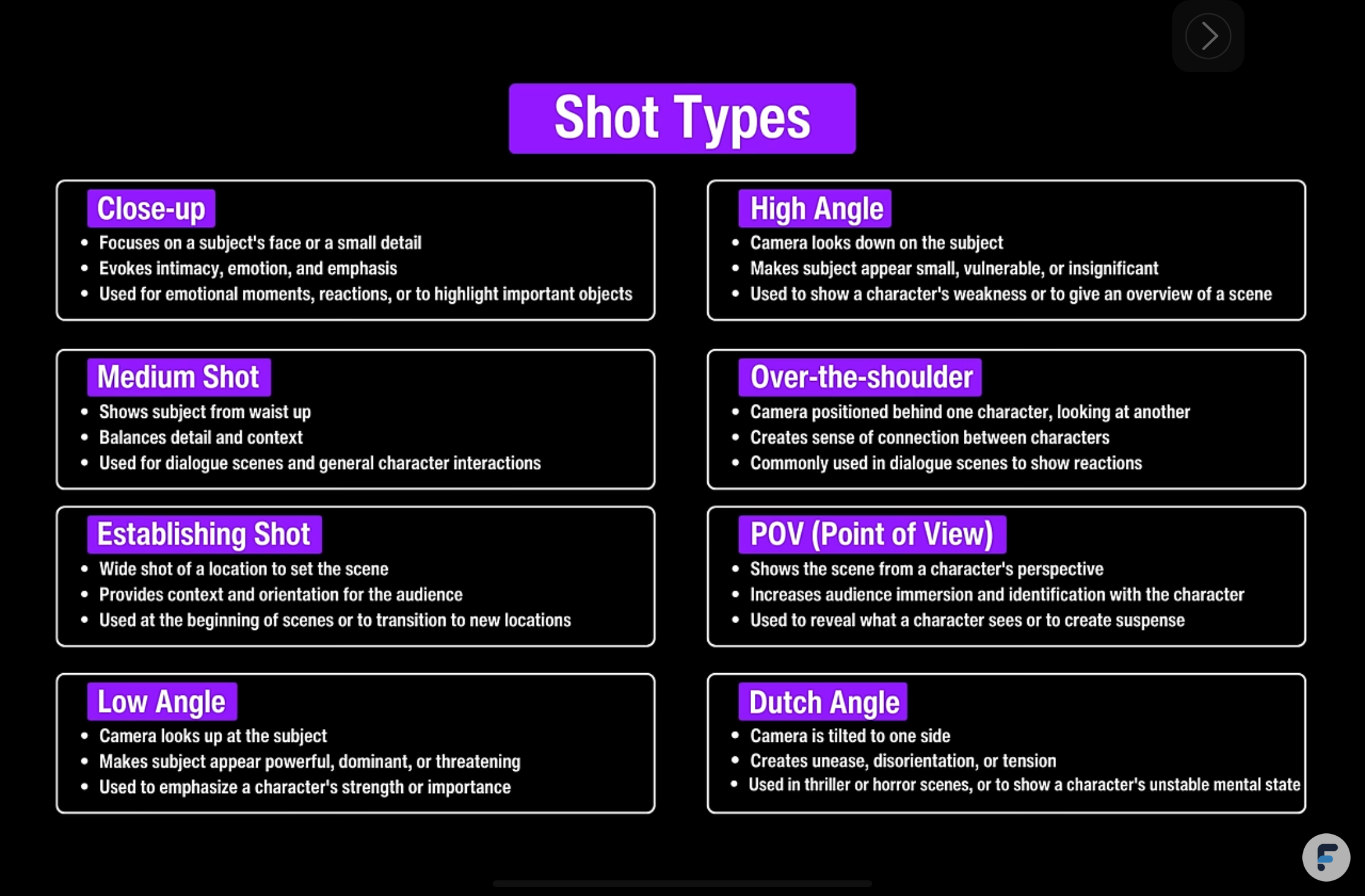🎟 Activity
This exercise shows how to create an illustrated storyboard by combining AI-assisted fiction writing with AI-generated images.
Activity Part A: Review storytelling and photo vocabulary
In this part of the exercise, you'll review professional storytelling and photography terms that can be useful for prompting AI to generate narratives.
- As a team, visit the Vocabulary tab of your Class Sheet and choose a row in the "Photo" or "Storytelling" category.
- Prompt our class chatbot for a definition of that term.
- Search the web for a human-generated definition of that term and add the URL for that web page to the appropriate column.
- Describe any differences between the AI- and human-generated definition in the appropriate column.
- Based on these two sources, add a definition of your own. This must be in your own words.
- Add your names to get credit in the appropriate column for this exercise.
Activity Part B: Write a story outline
In this exercise you'll create an AI-assisted text with pictures that represents a familiar story transposed to an alternative universe. Your job is to depict a sequence of events that differs from the standard narrative in some fundamental way. (The topic resembles but is not identical to the "break the cliche" Task.) Examples:
- An alternative timeline to our own in which the South won the Civil War.
- The story of your life if you had been born a different race or gender.
- A version of Star Wars in which Jar-Jar Binks is the chosen one rather than Anakin Skywalker.
- Spiderman but he's Karl Marx instead of Peter Parker.
Steps for generating a story outline:
- To help you brainstorm or flesh out an idea, ask the class AI for help before proceeding to the writing stage. For example, you might suggest some stories that interest you and invite the chatbot to suggest versions from alternative universes or "what if" scenarios. Or you might type in an idea that occurs to you and ask the chatbot to improve or offer variations on it.
- Once you have an idea for a story, work with the chatbot to generate a story outline. See the sample prompt in Recommendations below.
- Follow up with the chatbot to refine the outline incrementally. You may ask for tweaks to the central conflict, character arcs, climax, or denouement.
- Post the complete story outline to #alternative-universe-story.
- Looking over everyone's submissions, distribute 1-3 thumbs-up emoji (👍) to your favorite stories from other teams (you cannot vote for your own).
- As a class, discuss what worked and what didn't.
Activity Part C: Illustrate two or more scenes
- Ask the chatbot to describe the characters, and follow up to refine them until you're satisfied. Sample
prompt:
📍 Write a vivid and interesting background summary of the two main characters, including visual descriptions of their looks and clothing.Choose one or more terms in the Vocabulary tab of your Class Sheet that match the
- Rewrite the appearance and personality descriptions generated in step 3 as prompts for Leonardo.ai to depict your main characters.
🎩 Optional: ask the class chatbot to generate text-to-image prompts based on those descriptions for you.
- Generate and refine images for two of your main characters using the recommendations listed below to ensure consistent character design. Be sure to give each character a name as suggested in the recommendations.
- Rewrite (by hand or with AI) two of the scenes generated in part A to incorporate the character names.
- Ask the chatbot to generate images for both scenes, and refine them incrementally until you're satisfied
with the results.
🎩 Optional: Choose a different model (upper left in Leonardo interface) to see a different imagining of your character.
- Post both text and images corresponding to the scenes you chose, along with your
AI-assisted character descriptions, to #alternative-universe-images.
⚠️Start with a post for the first scene, then add each subsequent scene as a reply to your first post so we can see which image goes with which scene. Do not add all the images and text together in a single post.
- Looking over everyone's submissions, distribute 1-3 thumbs-up emoji (👍) to your favorite scene-and-image combinations from other teams (you cannot vote for your own).
- As a class, discuss what worked and what didn't.
⛑️ Recommendations for generating stories
Storytelling parameters you can add to your prompts
Sample prompt for a story outline
📍 Acting as a best-selling author of fantasy adventure novels, you will help me write a vivid, fast-paced short story. The story should break standard tropes and cliches, with surprising twists in plot, character development, or point of view. Your story should be based on the following parameters:
Main character 1: ________________
Main character 2: ________________
Genre: ________________
Plot summary: ________________
Setting: ________________
Point of view: ________________
Mood: ________________
Write a short story divided into 6-12 paragraphs corresponding to different scenes. Clearly label each paragraph with a scene number and location; an example might be "Scene 1: The Amazon Jungle," "Scene 2: The University Laboratory," and so on.
⛑️ Recommendations for generating images
Tune the image style
Choose an image model and style that makes sense for your genre, eg 3d Animation Style for a children's story or Isometric Fantasy for a game narrative.
Generate consistent character designs
Choose the same model for every image. (Don't pick the same seed.)
Pick a unique name for each character (eg, using BehindTheName.com and refer to that name in every prompt for that character.
Photography parameters you can add to your prompts
Common shot types

